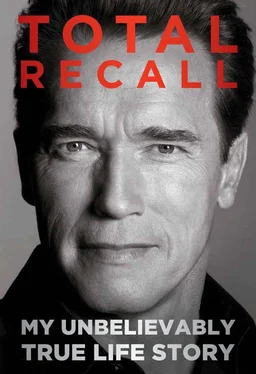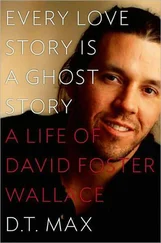They complained about the design expenses also. The restaurants all sold merchandise, from cool-looking bomber jackets to caps to key chains, and these were being refreshed and updated constantly. Fans would try to see how many Planet Hollywood T-shirts from different cities they could collect. Sometimes a customer would show up at an opening with thirty T-shirts for me to sign because he or she had been to thirty cities all over the world. It was a good, good spin. But stockholders would still want to know, “Why are you designing jackets and merchandise all the time? Why don’t you keep the same ones?”
The biggest pressure from the public markets was to expand. Wall Street was in the heat of the internet boom, and investors demanded fast growth. The founders, Robert Earl and Keith Barish, were each now worth about $500 million on paper because they still owned 60 percent of the stock. They promised to increase both total sales and the number of locations by 30 percent to 40 percent a year. This meant building restaurants in lots of second- and third-tier US cities like Indianapolis, Saint Louis, and Columbus, as well as in dozens more cities abroad. In April 1997, the month I had my heart operation, the company made a deal with Saudi billionaire Prince Alwaleed bin Talal to open almost three dozen Planet Hollywoods across the Middle East and Europe, starting with Brussels, Athens, Cairo, Lisbon, Istanbul, and Budapest. And it made a deal with a tycoon in Singapore, Ong Beng Seng, to build almost two dozen restaurants in Asia.
I kept telling Robert and Keith that this was a mistake. They were losing their grip on the central concept. If you went to the Planet Hollywood in Beverly Hills, you really might see Arnold. If you went to the one in Paris, you really might see beloved French film star Gerard Depardieu. If you went to the All Star Cafe in Tokyo, you really might see Ichiro Suzuki, the great baseball player. And in Orlando, you really might see Shaq during the years that he played there. But if you went to the Planet Hollywood in Indianapolis, would you see Bruce Willis having lunch? It started to feel like bullshit. We couldn’t deliver on that promise. By October, I was worried enough to ask Robert and Keith to come to my office and talk. We sat around the big conference table, just the three of us and Paul Wachter, and I made my pitch to them about fixing the strategy. We now had restaurants all over the world in great locations, I told them, and those held enormous potential that was still untapped. I had a whole presentation prepared on how to do that. For instance, we had a big opportunity to work with the studios on movie premieres. “Hollywood is turning out fifty movies a year,” I said. “Every one of those movies is going to open up across the United States and the world. So where do they hold the party?”
I wanted to bring studio executives into the business, fly them to the premieres, offer them perks, and treat them like kings so they would sit in their marketing meetings and say, “We’re going to open this movie with Planet Hollywood in Moscow, Madrid, London, Paris, and Helsinki—ten cities. In each city, we’ll have a screening at the restaurant, and then a huge screening at a local theater, and Planet Hollywood will host a big after-party. And here’s the good thing, guys: Planet Hollywood will fly the celebrities over and pay for the party. We’ll take care of the hotel rooms and all the other stuff involved in the premiere itself. By splitting the costs, we’ll save, and we’ll still get a ton of attention.”
Pulling off those kinds of deals meant that we would need a point person to schmooze with the studio. My first choice would have been Jack Valenti, the longtime head of the Motion Picture Association of America and Hollywood’s top lobbyist in Washington. Jack was a good friend and had been one of my closest advisors when I was chairman of the President’s Council on Physical Fitness and Sports. I thought we should go to him and say, “Jack, you’re seventy-five. You have done a terrific job for the movie business, but what are they paying you? A million dollars a year? Here’s two million a year. Relax. And here’s a pension, and here are benefits for your grandchildren.” All of a sudden we’d have Jack Valenti schmoozing all the studios and making the deals.
Another vital matter that I raised: our hamburgers and pizzas were good, but I wanted to serve more interesting food. And I saw huge potential in the merchandise. Rather than cut back our spending on design, I believed that we should do more. I was fascinated by the way fashion designer Tom Ford had gone into Gucci and transformed it from an old-fuddy-duddy company into a source for hip jackets and hip shoes. Before Ford’s arrival, I never bought from Gucci; all of a sudden, I was in their store.
“You’ve got to get a guy like that to design for Planet Hollywood,” I told Robert and Keith. “You need actual Planet Hollywood fashion shows that you can take to Japan, Europe, and the Middle East, so that people will want to have the latest Planet Hollywood stuff. Rather than always selling the same old bomber jacket, the bomber jacket should change all the time, with different kinds of buckles and with different kinds of chains hanging off it. If you make the merchandise snappy and hip and the newest of the new, you’ll sell tons of it.”
Throughout my pitch, Robert and Keith kept saying, “Yes, yes, great idea.” At the end, they promised to get back to me on the points I’d raised. But Paul had been the only person taking notes. “I don’t think they got it,” he said after they left. I’d hoped this would be a game-changing meeting, because promotion and merchandising were realms I truly understood. But I had the sense that Robert and Keith were overwhelmed. The pressure from the market was getting to them. While Robert was supposedly focused on operations and Keith on the strategic vision, mostly they talked about investor deals. And Planet Hollywood had reached a scale where it was no longer possible for two entrepreneurs to do it all. The company needed structure, and it needed people who were expert in managing a global operation. I’m a loyal person, and I stayed committed to the business for several more years. But its popularity declined steadily, and the stock fell and fell until eventually the company went bankrupt. Financially I did fine, thanks to the protections we had negotiated into my deal, although I made nowhere near the $120 million or so my stock had once been worth on paper. I was better off than the many shareholders who lost money, however, and better off than many of the other actors and athletes.
Even so, I’d love to do it again, only have it managed better. Whoopi, Bruce, Sly, and all the other big-name participants would tell you that Planet Hollywood was fun. With the huge parties, openings, and premieres, we met people all over the world and had the time of our lives.
MARIA HAD A TERRIBLEtime with morning sickness while she was pregnant with Christopher in 1997. It got so severe that she had to check into our local hospital because she couldn’t keep anything down. I was worried even though she had good medical attention, and the kids were upset because Maria was gone. Katherine was only seven years old, Christina was five, and Patrick was three. To help them get through it, I put off commitments and spent a lot of extra hours at home trying to be both mom and dad.
I figured that what would reassure them most was making sure they saw Maria every day and otherwise keeping up the daily routine. Every morning on the way to school for the girls, we’d stop off at the hospital, and again in the afternoon. I explained to them that Mommy would want to have a part of home with her, so each morning before we left, we’d go into our garden and pick the most elegant flower to bring her.
Читать дальше












